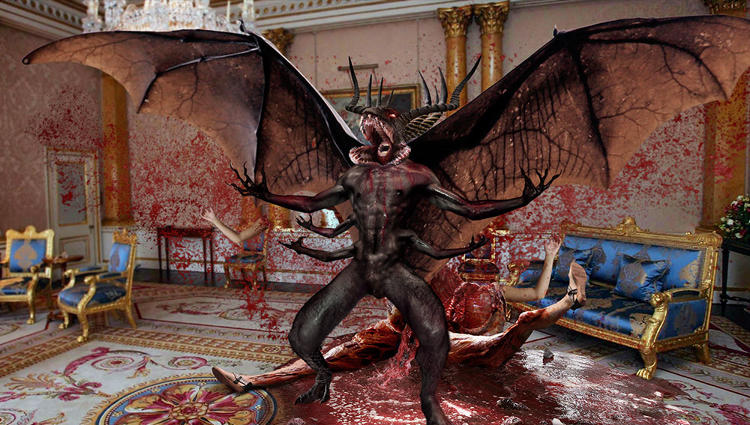However, if you were able to access the site, I asked that you only look at two articles and respond to the questions that follow after reading the background information on The Onion and excerpts from the article by Dan Nosowitz entitled The Look of Funny: How the Onion's art department works.
Questions: 1. What knowledge is needed by the writer to make the satirical article effective?
2. What societal issue is being addressed in the article? (textual support)
3. What satirical techniques are being employed. (support from video clip or text)
1. parody 2. burlesque 3. exaggeration 4. juxtaposition 5. analogy
6. comparison 7. double entendre
Today- Wednesday- if you completed the assignment, please read Thursday's information on Trevor Noah, who took over from Colbert; then watch the links. I am not asking for a written response, but would like to consider the observations from The Atlantic Monthly article.
If you have not completed The Onion assignment, use a computer that has access to it. That might mean moving your seat! These are due at the end of class today.
As I have nothing you must turn in on Thursday, use the time to complete any missing work. We are done with satire and moving on to photojournalism after the break.
The Onion
The Onion is an American digital media company and news satire organization that publishes articles on international, national, and local news. Based in Chicago, the company originated as a weekly print publication in 1988 in Madison, Wisconsin. In the spring of 1996 The Onion began publishing online. In 2007, the organization began publishing satirical news audio and video online, as theOnion News Network. In 2013, The Onion ceased publishing its print edition and launched Onion Labs, an advertising agency.[3][4]
The Onion's articles cover current events, both real and fictional, satirizing the tone and format of traditional news organizations with stories, editorials, op-ed pieces, and man-in-the-street interviews using a traditional news website layout and an editorial voice modeled after that of the Associated Press. The publication's humor often depends on presenting mundane, everyday events as newsworthy, surreal or alarming (https://en.wikipedia.org/wiki/The_Onion).





At The Onion, a fake news website and one of the great satirical outposts of the past 50 years, nearly every image is original: either a graphic created in-house, a photograph taken in-house, or an image so manipulated by Photoshop as to not represent any real event that has ever happened. The tiny graphics team at The Onion pumps out about 50 original pieces of art per week at a time when your average Internet publication arts stories as quickly as possible: with images the subject provided, or photographs from stock agencies and wire services. Nobody sits down and creates original art for a two-sentence post. Yet The Onion does, over and over again. Why bother?
As Stephen Colbert or any great satirist will tell you, a key to satire is to always stay in character. In The Onion’s case, that "character" is an absurd, alternative world invented to comment on the real one. Every aspect of the fake world has to ring true for the trick to work. That includes the visuals. When nothing you publish is real, every single image has to be made from scratch. "We want to make sure that we're making our Onion-world fully realized and very real," says Ben Berkley, managing editor of The Onion. It's all in service of the joke.
A Real (Fake) History
There is a real history of The Onion—started by two college students at the University of Wisconsin at Madison in 1988, eventually moved to New York and then, recently, back west to Chicago—but there’s also a fake history created by the writers of The Onion itself. In this history, The Onion was founded by a German immigrant named Friedrich Siegfried Zweibel ("zwiebel" is German for "onion") in 1765, named the "Mercantile Onion" because, according to The Onion book "Our Dumb Century," those were the only two English words Zweibel knew. Also in the fictional history of The Onion: The Onion News Network, ONN, was founded several years before television itself was invented; the grandson of the founder, editor T. Herman Zweibel, a conservative firebrand who once opposed television characters sleeping in the same bed, eventually left the planet Earth; and in the span of a week in 2009, The Onion was sold to a Chinese conglomerate Yu Wan Mei Amalgamated Salvage Fisheries and Polymer Injection Corporation and subsequently sold by the same Chinese conglomerate.
There is a real history of The Onion—started by two college students at the University of Wisconsin at Madison in 1988, eventually moved to New York and then, recently, back west to Chicago—but there’s also a fake history created by the writers of The Onion itself. In this history, The Onion was founded by a German immigrant named Friedrich Siegfried Zweibel ("zwiebel" is German for "onion") in 1765, named the "Mercantile Onion" because, according to The Onion book "Our Dumb Century," those were the only two English words Zweibel knew. Also in the fictional history of The Onion: The Onion News Network, ONN, was founded several years before television itself was invented; the grandson of the founder, editor T. Herman Zweibel, a conservative firebrand who once opposed television characters sleeping in the same bed, eventually left the planet Earth; and in the span of a week in 2009, The Onion was sold to a Chinese conglomerate Yu Wan Mei Amalgamated Salvage Fisheries and Polymer Injection Corporation and subsequently sold by the same Chinese conglomerate.
That skewed, surreal tone permeates The Onion’s strange editorial approach—a combination of fake New York Times and fake cheeseball local paper—along with a few other publications taking on other media types. Notably, that includes the new site Clickhole, a parody of pageview-desperate posts on sites ranging fromBuzzFeed to the Huffington Post to Upworthy. (Clickhole has its own photo editor, and the teams for The Onion’s videos are separate. Even more separate is the AV Club, a non-satirical criticism and reviews site, formerly a section within the physical Onion newspaper, that discusses movies, TV, books, games, and music.)

What The Onion does is more difficult than it seems; just look at less successful copycats, like the Daily Currant, to see what a high-wire act satirical journalism is. But The Onion is doing more than just writing fake news; with just a handful of writers and a three-person art department, it has managed to create what television and movies often fail to do: a fully-functioning, fascinating world just different enough from our own to serve as a damning critique of it.
No comments:
Post a Comment